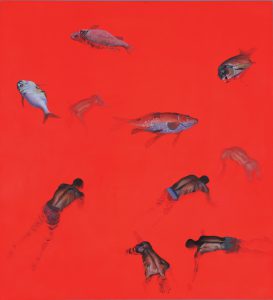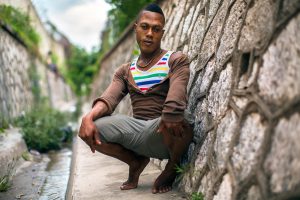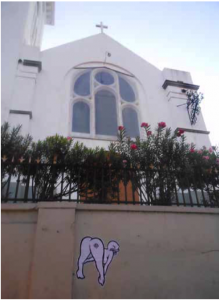Johnson Collective Curatorial Statement
“When your child choose a course God didn’t cut out for him, you dish him dirt…You wash your hands clean. You banish him from your life…Banishment, me son, banishment.”
Patricia Powell, A Small Gathering of Bones, p.37.
The want to belong and be accepted by one’s community is a natural human desire that for many people comes with little difficulty—simply being “oneself” is enough. However, this is only true when one is born destined to fit the social norms of his or her respective society. These fortunate subjects probably will never know the taste of social rejection, but the same cannot be said for those who don’t fit these standards. For them, life becomes a performance where their private self and public self are not one of the same—simply being “themselves” isn’t enough. In many cultures, this dominating force is heteronormativity: the social construct where heterosexuality is strictly preferred over other queer identities and governs gender roles accordingly. For heterosexuals, these forces are far from threatening, perhaps even going unnoticed, since these subjects naturally assume their expected forms of behavior. But for those subjects who do not abide by this heteronormative structure, these forces suffocate and make it impossible, or even deadly, to publicly embody and live these identities. This is the unfortunate reality in the Caribbean where heteronormative culture dominates many of its islands, especially Jamaica, and leaves queer subjects in a place of precarity.

This phenomenon has been explored by many Caribbean artists and writers who have attempted to both understand and complicate the queer narrative by connecting the modern experience of queer people in the Caribbean to the historical context of colonialism. Such a positioning is especially evident within the artwork of Leasho Johnson, who through pieces such as Lost at Sea, ii and his Church is in session series explores the queer experience amidst the heteronormative climate of Jamaica. The overt violent themes in Johnson’s work not only reflect the hostility and suffering faced by Jamaican gays in a contemporary context, but even extend beyond. The bloodshed and bobbing of black bodies in Lost at Sea, ii offer a macabre reminder of the brutality faced by enslaved Africans during the Middle passage and colonial period. Within a modern context, the sanguine glare of the artwork can be representative of the AIDS crisis that claimed countless queer lives worldwide during the late 20th century.
Such a tragedy is illuminated in literary works as well, such as Patricia Powell’s novel, A Small Gathering of Bones, that offers a glimpse into the onset of the AIDS epidemic in 1970s Jamaica. Powell introduces readers to the unfortunate lack of understanding surrounding the disease and to the interpersonal conflicts, whether romantic, social, or familial, that are experienced by queer Caribbean subjects. Her story of the love triangle between Dale, Nevin and Ian puts into perspective the risky sexual promiscuity often associated with queer culture, but more impactfully shows the performative quality of masculinity that is necessary to conceal their vulnerability as gay men, for when they are discovered they are disowned or banished by society, and even by their own family. The fear of being discovered haunts Powell’s characters, and understandingly so given the notoriously oppressive climate against LGBT-identifying individuals in Jamaica.

As reported by NBC News, Jamaica “remains one of 76 countries where consensual same-sex relationships are criminalized,” and as if such laws aren’t already discriminatory enough, the unjust violence faced by the gay community in Jamaica makes it so that the lives of all LGBT-identifying individuals, whether in a relationship or not, are threatened (Compton 2016). Jamaican LGBT activist Gareth Henry was inspired to help the queer community in Jamaica after the deaths of 13 of his friends from homophobic attacks. Henry’s own life was once threatened by an officer while stopped at a traffic light who said he would kill Henry because the officer suspected he was gay, which led Henry to file for refugee status and move to Canada. This lack of acceptance and sense of belonging is a theme that threads throughout the aforementioned Caribbean works of art and literature.

In Jamaica, banishment has manifested itself in ways that are visible outside of literature. Many young gay and trans youth live on the streets in the gully’s of Jamaica. Vice News’ 2014 documentary entitled Young and Gay: Jamaica’s Gully Queens shows viewers the LGBT youth—the self-proclaimed Gully Queens—who have been banished from home. The Gully Queens form families and homes of the gullies, which are ravines that worm water through Jamaica. They support themselves by selling weed and loose cigarettes or through sex work, both of which place them in vulnerable situations as they wander the street looking for patrons. In particular, trans-women who participate in sex work risk their lives daily due to the possibility of being discovered as not biologically female by their patrons, who may respond violently. Because of these grim possibilities, the gullies offer safety and seclusion to its queer inhabitants that would not be available if they lived on the streets. Yet it would be fallacious to claim these subjects are wholly safe in their living arrangement, since most Jamaicans know that the gullies are the homes of gay and trans youth. As the documentary shows, this knowledge means anyone with the intent or desire to do harm to these queer individuals can easily do so, and they often do. Direct acts of violence, such as setting fire to part of the gully, are not uncommon occurrences. Furthermore, these acts are not only targeted to queer men, but also are experienced by lesbian and bisexual women. These queer females experience rape as a form of hate crime to “straighten them out” and often cannot seek out legal help because of their LGBT identity. This lack of protection from the state means these LGBT-identifying men and women have to forge their own ways in the name of ensuring that some things remain sacred. Public space is one of them.
There are contradictions at the heart of these issues, which Leasho Johnson’s work attempts to make sense of through popular Jamaican culture, specifically Dancehall. State practices figuratively and literally uphold heteronormativity and normative modes of masculinity (and do the same by upholding normative modes of femininity) by turning a blind eye to violence against those who lack the class and gendered privileges to “blend in.” In this way, the state defines what is sacred in Jamaican society and the church acts as an apparatus to further these notions. However, Jamaican Dancehall queers these binaries, creating new standards for what is sacred and profane, turning notions of respectability, which are inherently classed and gendered, on their head.

In his pieces such as his 2014 work, 6:30, which is pasted onto the wall of Kingston Parish Church, we see Johnson trying to bring to light the contradictions emerging out of questions regarding the public and private, the sacred and profane. We see something similar happening in Johnson’s Pum-pum Tune-up East and West and Pum-pum Tune-up dive from his Church is in session series. The dancehall space becomes the church and the pum-pum becomes that which is held sacred. In her article titled, “‘Church inna Session:’ Leasho Johnson, Mapping the Sacred through the Profane in Jamaican Popular Culture,” Patricia Joan Saunders asserts that “pum-pum tun-up” which, in Jamaican patois means good pussy, “connotes high quality, exceptional stature or power, or (in the interest of not overstating the obvious), as one of Johnson’s titles indicates, “the good hole” (Sanders, 96).
Therefore, we see Johnson conveying not only the existence of popular Jamaican culture, but also its inherent relationship to the larger culture which marks Dancehall as deviant. His small, hand-held, clay figures convey the way in which the dance hall is a space of self-formation, claiming new forms of power and sexuality performed within and outside of the social norms of Jamaica’s larger society. The pum-pum is both consecrated through Dancehall and consecrates the dance halls.
Works Cited:
vicenews. YouTube, YouTube, 28 July 2014, www.youtube.com/watch?v=ILXVpFQVEbw.
Saunders, Patricia Joan. “‘Church Inna Session’: Leasho Johnson, Mapping the Sacred through the Profane in Jamaican Popular Culture.” Smallaxe.net, Caribbean Queer Visualities, smallaxe.net/cqv/issue-01/pdfs/CQV-086 patriciaJ-SAUNDERS.pdf.
Compton, Julie. “Gay Jamaican Refugee Helps Others Flee Persecution.” NBCNews.com, NBCUniversal News Group, www.nbcnews.com/feature/nbc-out/outfront-gay-jamaican-refugee-helps-others-flee-persecution-n696551.